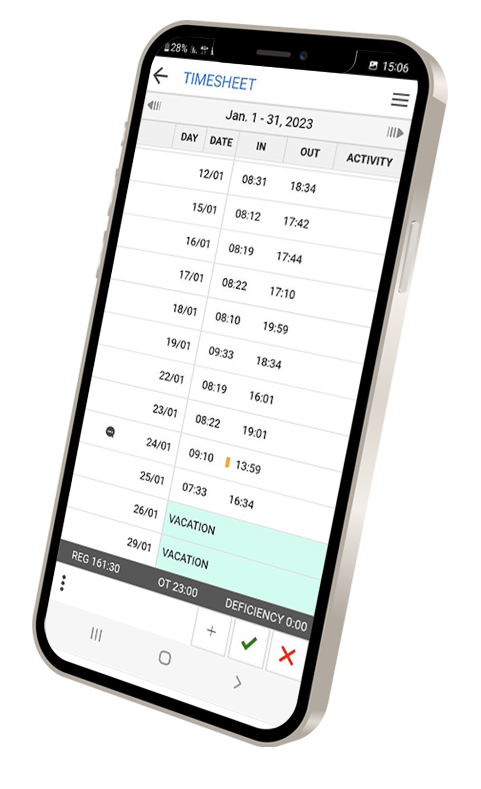Key Features
CoreHR
Adding corporate hierarchy filters – from now on, companies that handle several subsidiaries and/or sites can handle employees separately in each company/site/dept, by using the new filter. Saves valuable operating time.

Attendance and absences
Moving clock-in/clock-out punches over within the same record – Effective this release, users can easily move punches over by drag-and-drop instead of deleting punches and re-entering them because of incorrect reporting. Quick and efficient.

Adding a first pair of clocking-in/out records – Working from home before going out to the office? Forgot to add first pair of punches? From now on, the user will be able to add the first pair of clocking in/our records in a day without having to move records. This is effective especially in organizations that operate in a hybrid model.

- Add contracts automatically to system administrators – in your capacity as the system administrator do you have access to all agreements in the system? From now on you do not need to remember adding new contract to your access rights in profile editor. The new contract will be added automatically. Saves time and prevents errors.
- Work from home pop-up message – Using “Work from Home” attendance code? When you change the daily clocking-in/clocking-out punch manually, you can set a pop-up that asks user if s/he works from home. By selecting “Yes”, the “work from Home” attendance code will be updated automatically. Improves control and reduce manual updates in hybrid organizations.

- Mobile – Display attendance totals without turning the mobile device over – the mobile application will display the totals of the attendance directly on the screen and without the need to turn the mobile device over.


- Disable Mobile location – clocking-in/out using the Synerion Mobile Pro app allows clocking in/out from authorized areas/anywhere as selected by the customer. From now on, you can set location as optional. By doing so, the location will not be documented by the system.


- Copying the note from an “absence request” to attendance – The employee’s note when requesting absence can be copied over to the daily attendance; once enabled, the daily notes will be Synched. Even more efficient.
Labor costing
My default Jobs – Do you report on jobs or a regular basis? How about your employees? From now on, system administrators will not be required to manage and maintain the employees’ default jobs: Allow employees to define their-own default jobs and ensure that there are no shortfalls. Simple and straightforward.


- Expanded jobs descriptions – We have expanded the TC level names hence no need to “shorten” long names of work orders/projects/jobs/processes.
Scheduling
Hiding inactive corporate hierarchy levels – we added the option of removing the display of inactive organizational levels such as sites/departments. Once set to inactive, those organizational levels will no longer be displayed to schedulers, thereby preventing errors and unnecessary maintenance as a result of assignment to inactive departments. Organizing and simplifying processes.

- Adding a new display attribute to Employee Management Scheduler – we added a feature for selection that will be added to the scheduling cell e.g. department or profession etc.). This way, the manager will be able to get a clear picture about the employees’ assignments without hoovering/drilling-down to each assignment. Simple and intuitive.


- Add a “approve all” option to Shifts trading management – an employee who was assigned to a shift may request to change/cancel the shift. Other suitable employees may submit a request to be assigned to the shift that has become available. Now, the manager can approve all requests at the same time i.e. if the number of employees assigned exceeds the number of employees needed, an alert will be issued. Simple and efficient.

Mobile/self-service – Display partial absences in schedule – from now on, the Mobile/ESS scheduling screen will also include a display of partial absence, should the employees have any such absences.

Other topics

- API improvements – Customers who set up and update the employees in the payroll/ ERP system will be able to present in those systems a full list of the levels of organizational hierarchy, list of contracts, and SD profiles. These improvements help to make the integration even “tighter”.

- Adding support in extended addresses in the Excel reports generator (RG) – we added support to the extended addresses table (city, street, house number, flat, zip code, POB), such that from now on it is possible to add the address field to all report types based on the employee’s file.

- Two-Factor Authentication to system administrators and managers from the ‘users’ table (Cloud customers) – System administrators are exposed to information of other employees, and sometimes to sensitive data, including set up tables, employee file data and more. Starting from this version, it is possible to define for these users a multi factor (MFA) authentication, such that whenever they login to the SD system, users will be asked to go through further authentication beyond their password – through a code that was sent to the email.

